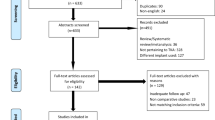Abstract
Background
In total knee arthroplasty (TKA), advances in posterior-stabilized (PS) knee implant designs address patellofemoral mechanics and cam–post engagement in an effort to reduce patellofemoral pain and improve knee kinematics. Such modifications may include improved femoral rollback, improved femoral dislocation resistance, minimized wear, and improved longevity.
Questions/Purposes
In this study, we compared a newer PS knee design that incorporates a left and right specific femoral component and smoother trochlear groove to improve patellofemoral mechanics with an older PS design in order to assess patellofemoral pain, manipulation rates, and revision rates.
Methods
Using an institutional database, we retrospectively identified TKAs performed by the same surgeon using the Logic® PS knee system and the older Optetrak PS knee system (Exactech Inc., Gainesville, FL, USA), with a minimum 2-year follow-up. Clinical outcomes for each cohort were measured using the Knee Society Clinical Rating System, University of California Los Angeles Activity Scale, pain visual analog scale (VAS), Veterans Rand 12-Item Health Survey, and Western Ontario and McMaster Universities Osteoarthritis Index. In addition, rates of anterior knee pain, manipulation, and revision were compared between the two knee systems, and a Kaplan–Meier survivorship curve defining failure as need for revision was calculated to allow comparison between the cohorts.
Results
From 2000 to 2018, there were 1482 TKAs performed using the Logic PS (not counting 12 patients who had died) and 445 in the Optetrak PS group (not counting 20 patients who had died). In the Logic PS and Optetrak PS groups, respectively, the average age at operation was 66.7 years and 68.6 years and the average body mass index was 30.8 and 31.2. Pain VAS scores were significantly lower in the Logic PS group than in the Optetrak group (1.72 vs. 2.75 out of 10, respectively). There was also a significant difference in the percentages of patients reporting anterior knee pain in the Logic group, as compared with the Optetrak group (5.6% vs. 11.8%, respectively). In addition, manipulation rates differed significantly between the Logic and Optetrak groups (0.34% vs. 10.70%, respectively). The revision rates were 1.15% for the Logic group and 2.0% for the Optetrak group. However, there was a significant difference in rates of revision performed because of osteolysis, favoring the Logic group (0.07% vs. 0.6%). The Kaplan–Meier survivorship curve shows a significant difference in time until revision between the Logic and Optetrak groups.
Conclusion
Design modifications to improve patellofemoral mechanics demonstrated significant improvements in overall pain and patellofemoral pain and reduced manipulation rates post-operatively.


Similar content being viewed by others
References
Bartel DL, Bicknell VL, Wright TM. The effect of conformity, thickness, and material on stresses in ultra-high molecular weight components for total joint replacement. J Bone Joint Surg Am. 1986;68(7):1041–1051.
Ehrhardt J, Gadinsky N, Lyman S, Markowicz D, Westrich G. Average 7-year survivorship and clinical results of a newer primary posterior stabilized total knee arthroplasty. HSS Journal. 2011;7(2):120–124.
Furman BD, Lipman J, Kligman M, Wright TM, Haas SB. Tibial post wear in posterior-stabilized knee replacements is design-dependent. Clin Orthop Relat Res. 2008; 466(11):2650–2655.
Gilbert SL, Rana AJ, Lipman JD, Wright TM, Westrich GH. Design changes improve contact patterns and articular surface damage in total knee arthroplasty. Knee. 2014;21(6):1129–1134.
Mannion AF, Kämpfen S, Munzinger U, Kramers-de Quervain I. The role of patient expectations in predicting outcome after total knee arthroplasty. Arthritis Res Ther. 2009;11(5):R139.
Petersen W, Rembitzki IV, Brüggemann GP, et al. Anterior knee pain after total knee arthroplasty: a narrative review. Int Orthop. 2014;38(2):319–328.
Robinson RP. Five-year follow-up of primary Optetrak posterior stabilized total knee arthroplasties in osteoarthritis. J Arthroplasty. 2005;20(7):927–931.
Rubinstein Jr RA, DeHaan A. The incidence and results of manipulation after primary total knee arthroplasty. Knee. 2010;17(1):29–32.
Ruel A, Pui C, Westrich G. Design modifications may improve range of motion following posteriorly stabilized total knee replacement: a matched pair study. HSS J. 2014;10(3):256–259.
Author information
Authors and Affiliations
Corresponding author
Ethics declarations
Conflict of Interest
Jeremy A. Dubin, BA, and Ahava Muskat, BA, declare that they have no conflicts of interest. Geoffrey H. Westrich, MD, reports personal fees from Exactech, during the conduct of this study.
Human/Animal Rights
All procedures followed were in accordance with the ethical standards of the responsible committee on human experimentation (institutional and national) and with the Helsinki Declaration of 1975, as revised in 2013.
Informed Consent
Informed consent was waived from all patients for being included in this study.
Required Author Forms
Disclosure forms provided by the authors are available with the online version of this article.
Additional information
Level of Evidence: Level III: Retrospective Cohort Study
Rights and permissions
About this article
Cite this article
Dubin, J.A., Muskat, A. & Westrich, G.H. Design Modifications of the Posterior-Stabilized Knee System May Reduce Anterior Knee Pain and Complications Following Total Knee Replacement. HSS Jrnl 16 (Suppl 2), 344–348 (2020). https://doi.org/10.1007/s11420-019-09742-7
Received:
Accepted:
Published:
Issue Date:
DOI: https://doi.org/10.1007/s11420-019-09742-7




